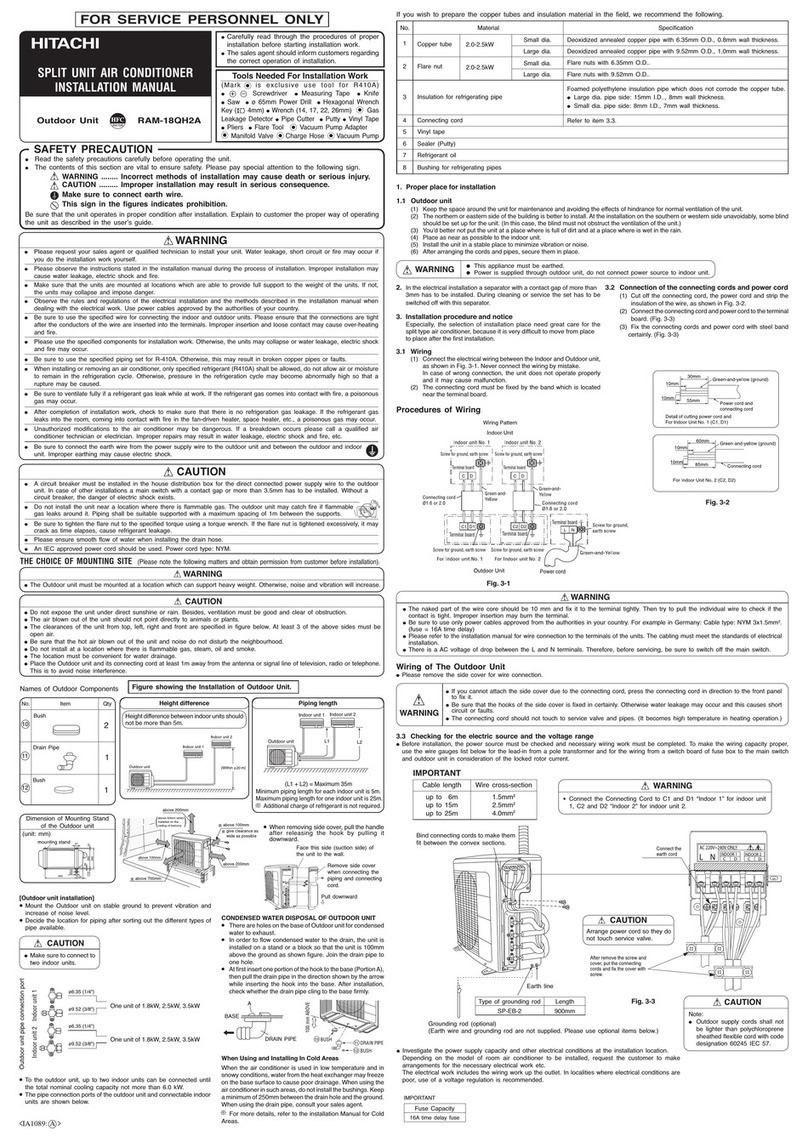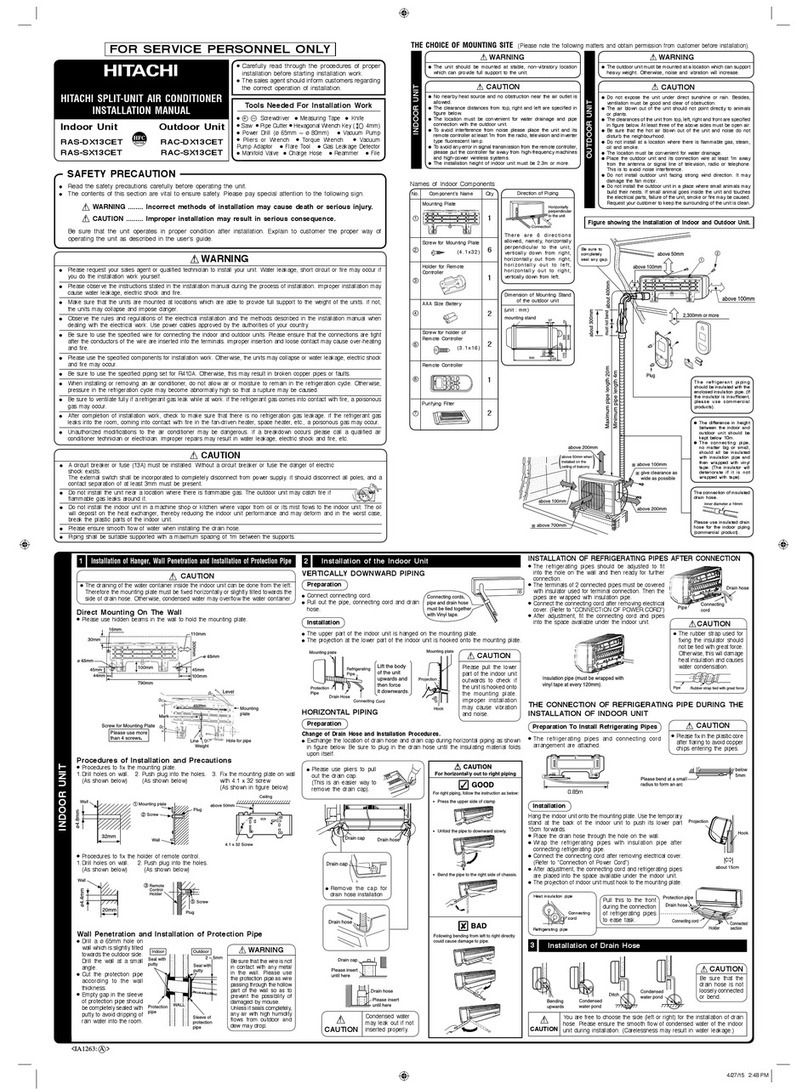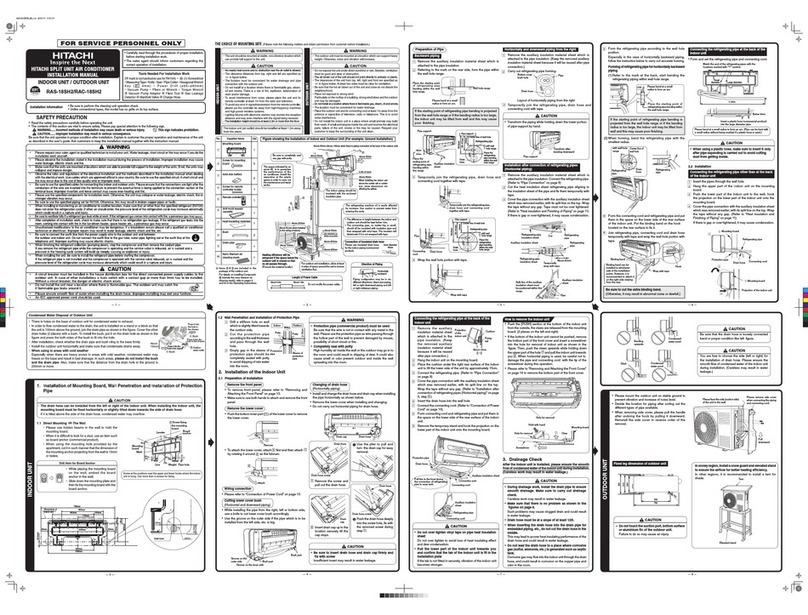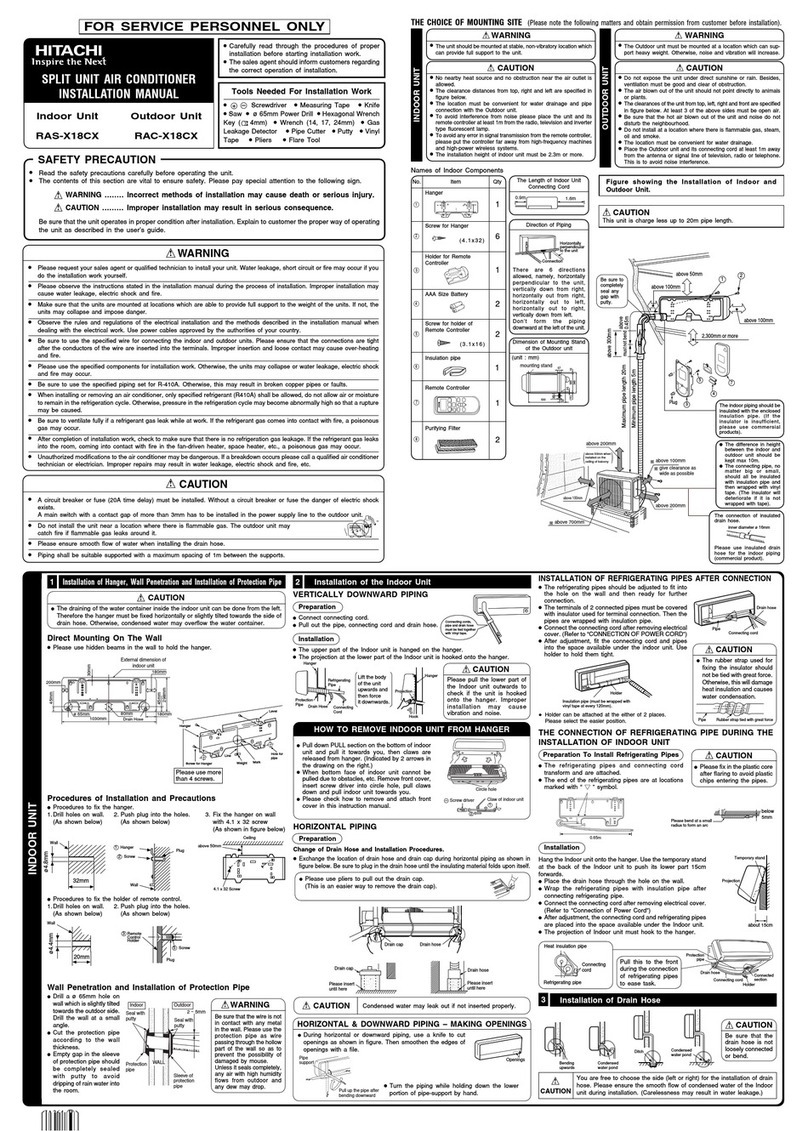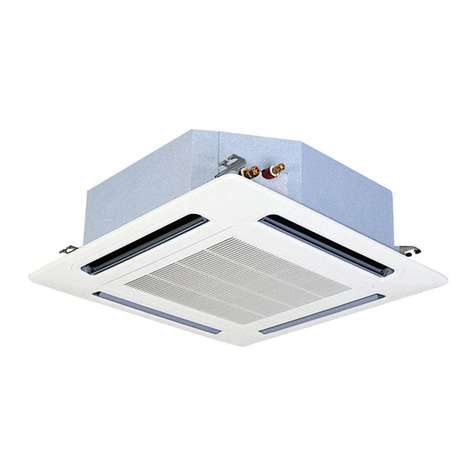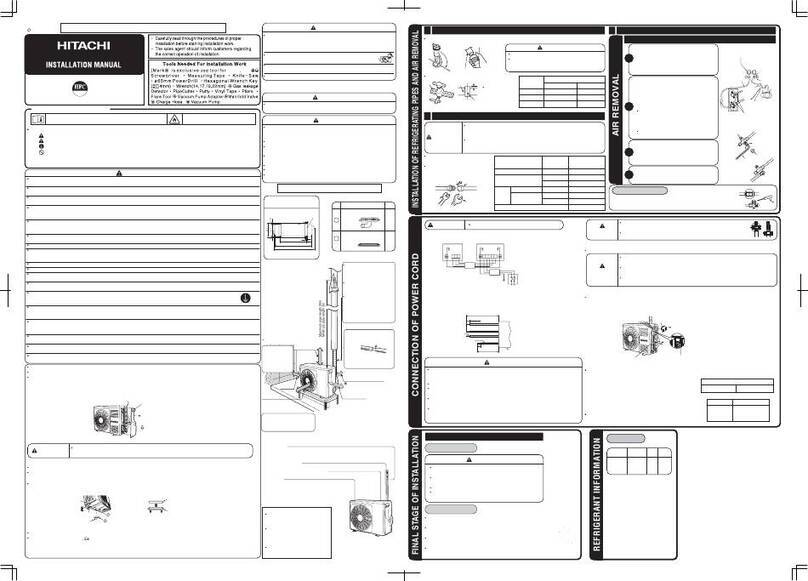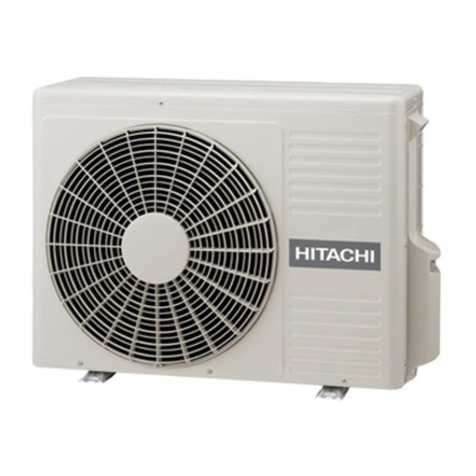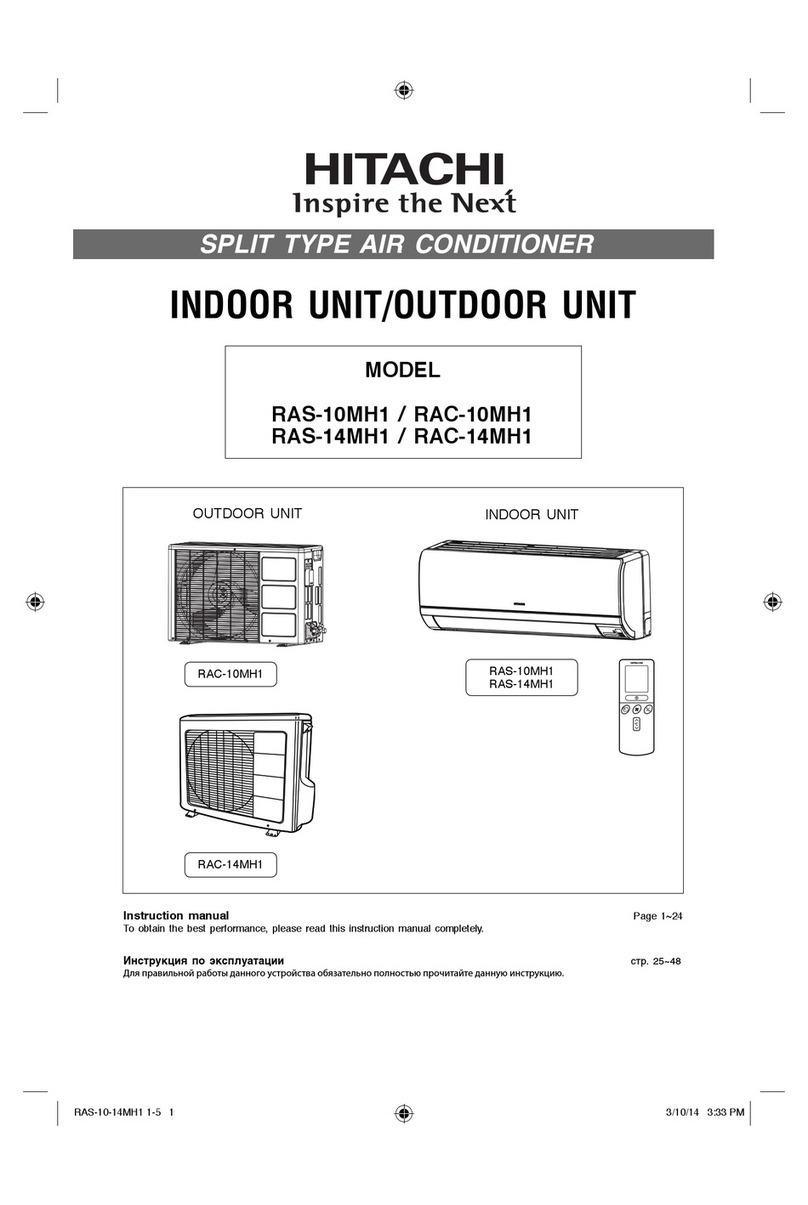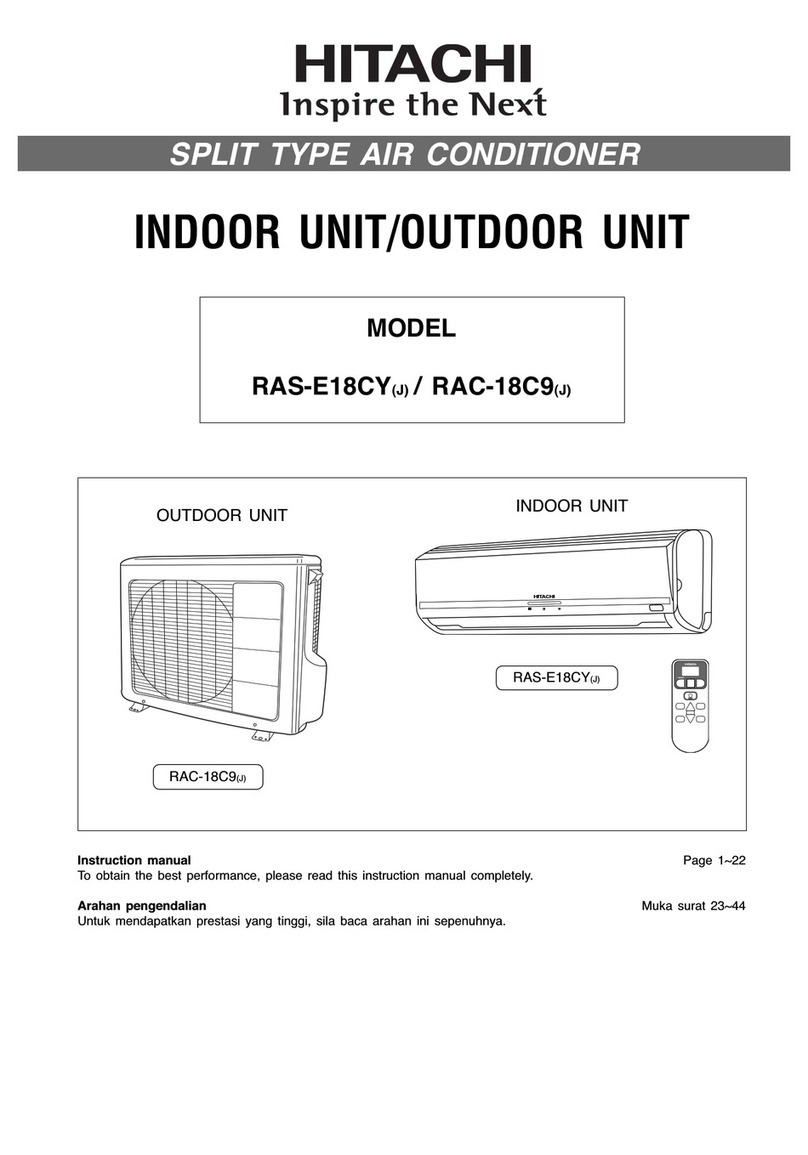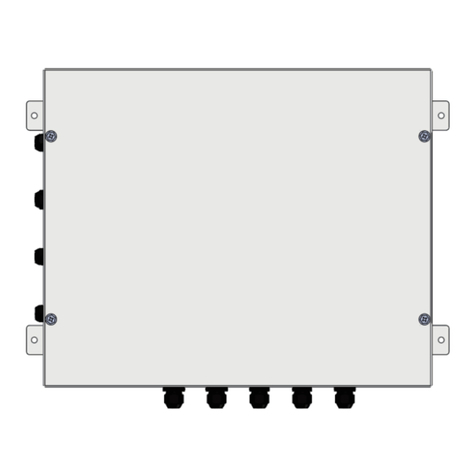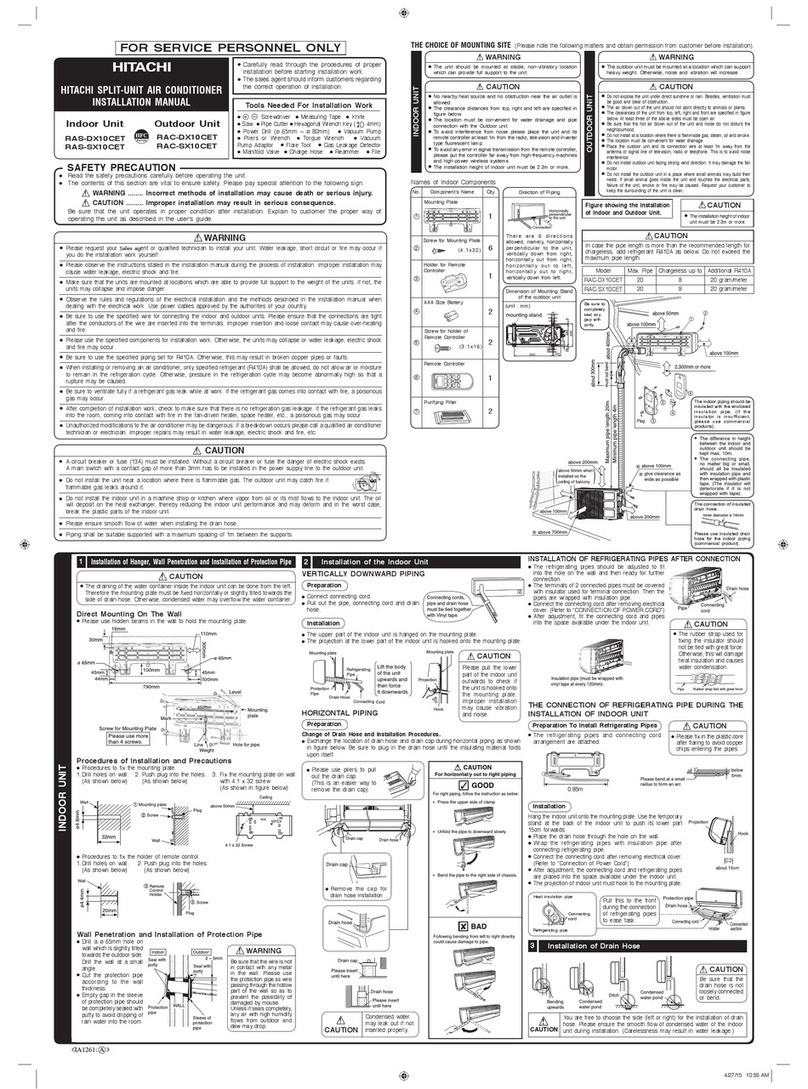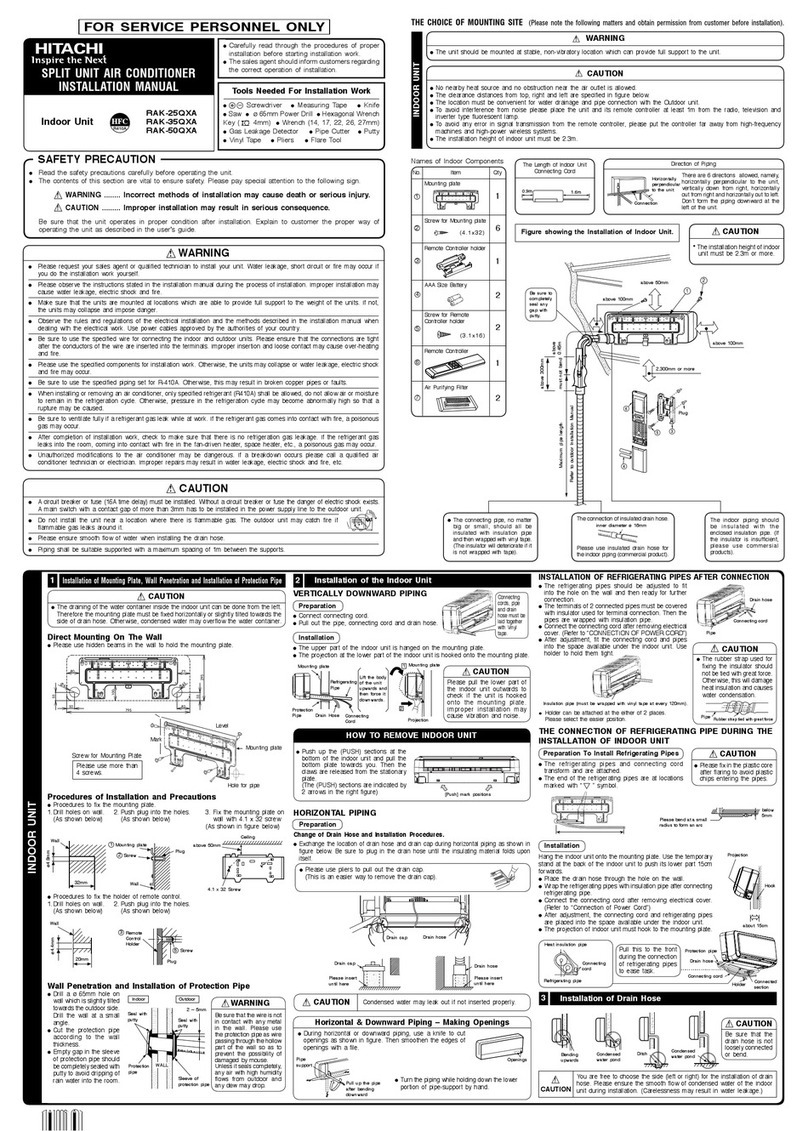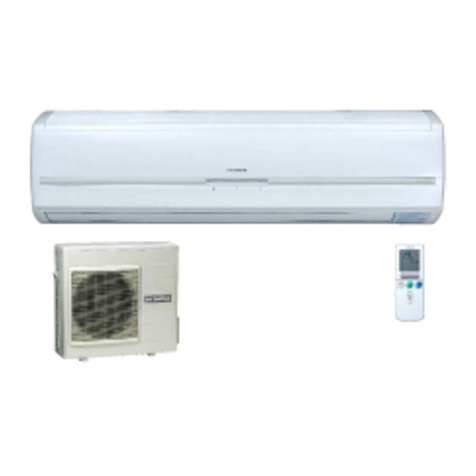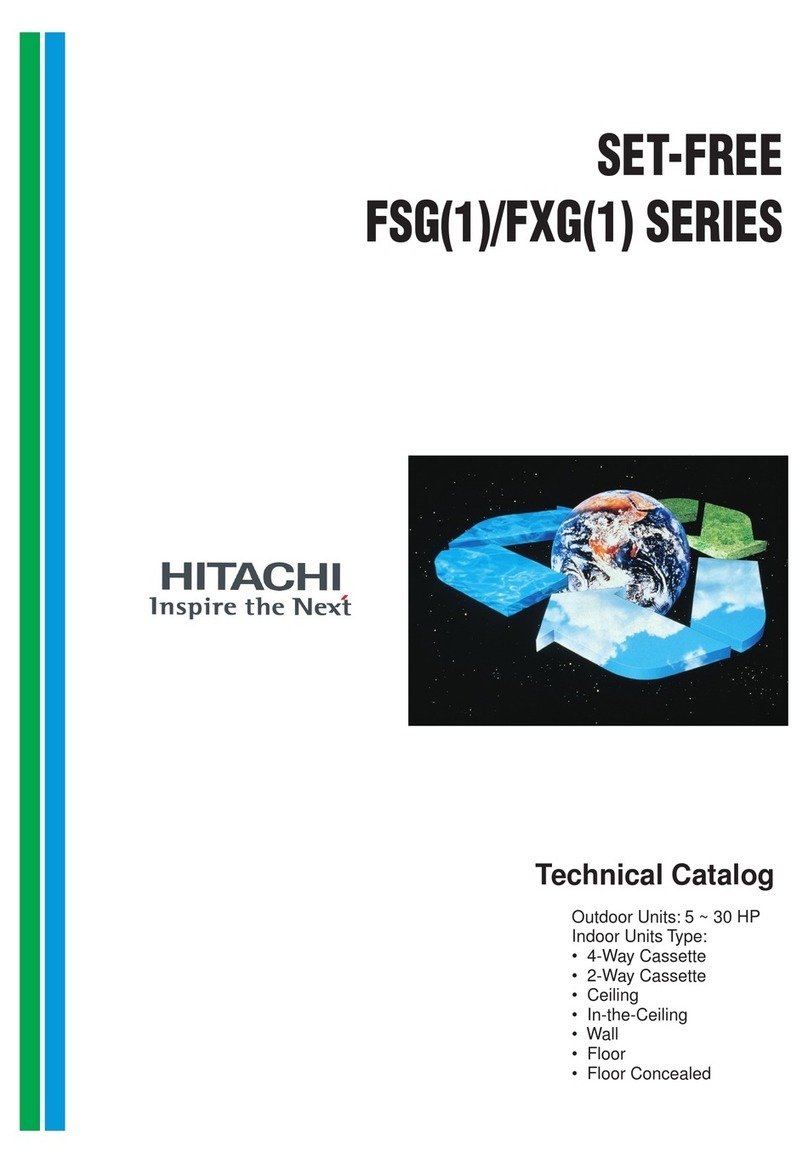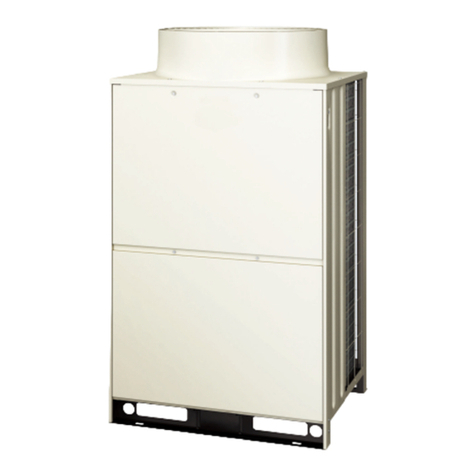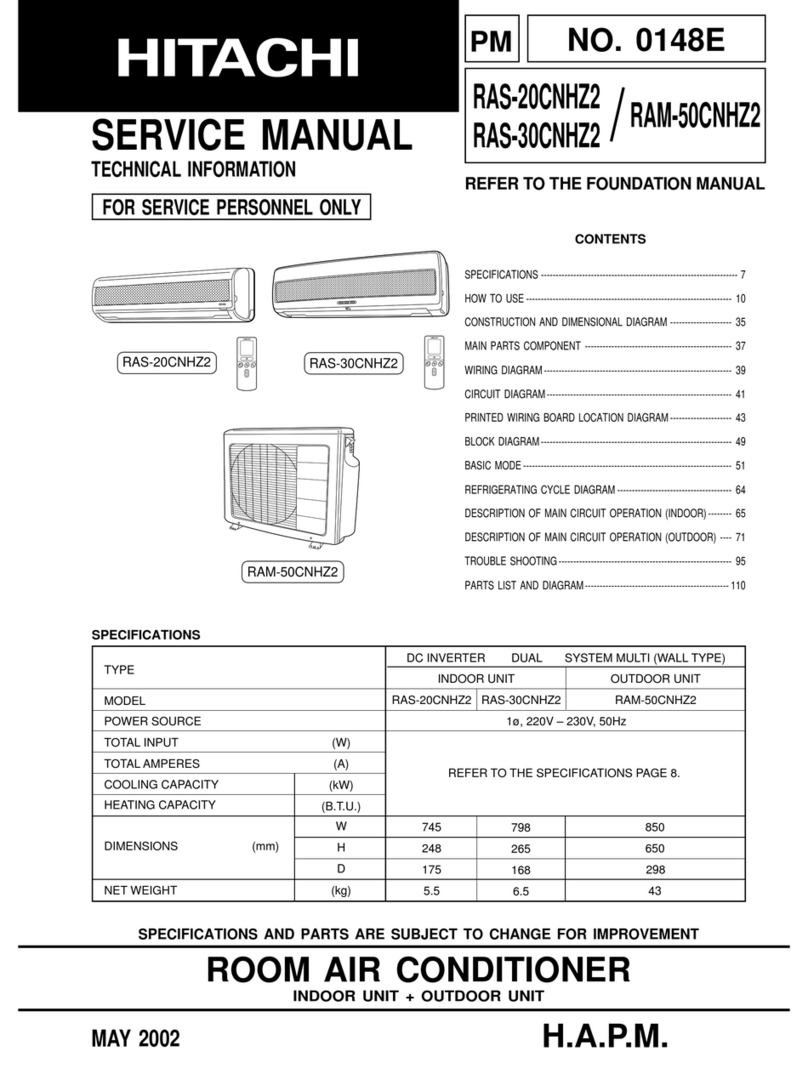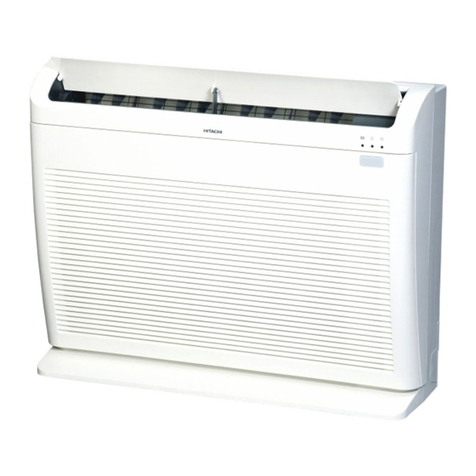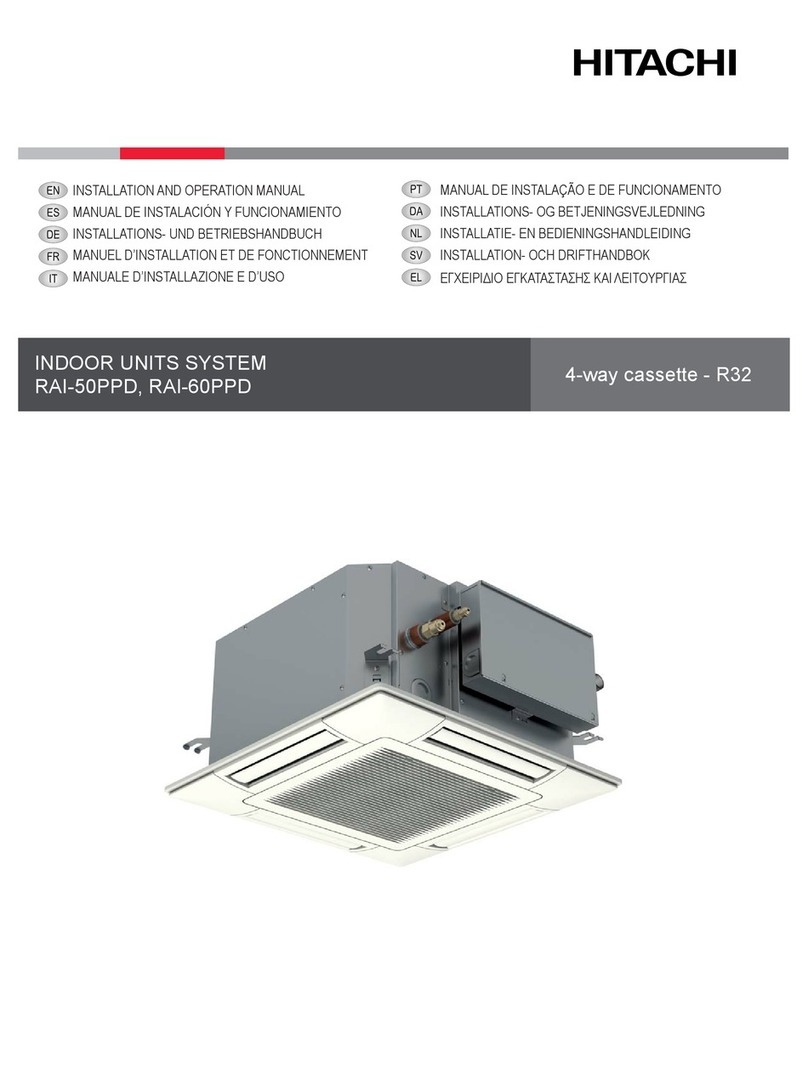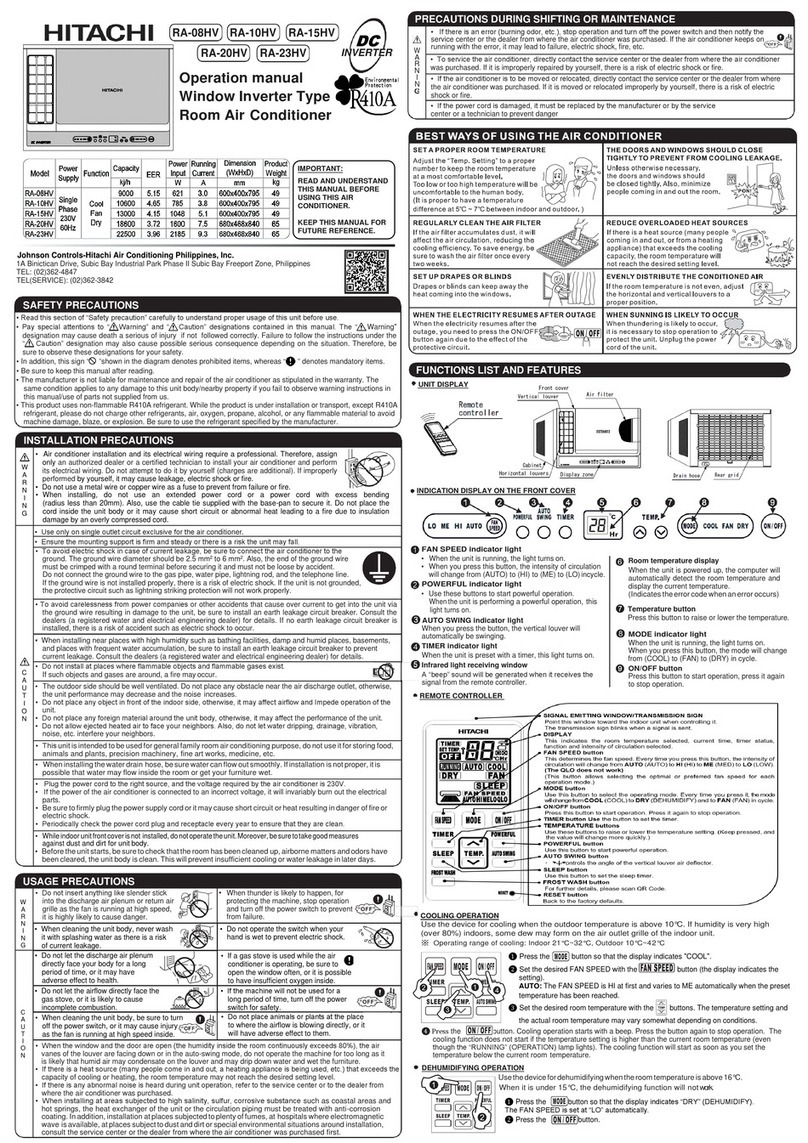Address
Wrench Torque wrench
Flare nut
Half union
Female side
Male side
INSTALLATION OF REFRIGERATING PIPES AND AIR REMOVAL
REMOVING AND ATTACHING THE FRONT COVER
1. Pipe Cutting and Flaring
•
Use a pipe cutter to cut the pipe and remove burr.
CAUTION
•
Remove burr
If burr is not removed, it may cause leakage.
• Point the side to be trimmed downwards during
trimming to prevent copper chips from entering the
pipe.
2. Pipe Connection
•
Remove the flare nut from the pipe of the indoor
unit by removing the flare nut (female side) with a
spanner while holding down the half union (male
side) with a spanner.
•
Do not crush the pipe while bending it.
•
Apply refrigerant oil on the connection part. After
carrying out the center alignment and manual
tightening of the flare nut, tighten the flare nut
securely with a torque wrench (spanner).
Copper pipe
Trimming tool
•
Before flaring, please put on the flare nut.
Copper pipe
Die
A
Die
Please use exclusive tool for refrigerant R410.
Outer Diameter A (mm) Rigid Flaring Tool
(ø) For R410A tool For R22 tool
6.35 (1/4
”
) 0~0.5 1.0
9.52 (3/8
”
) 0~0.5 1.0
3. Remove of Air from the Pipe and Gas Leakage Inspection
CAUTION
•
When removing flare nut of the indoor unit, first remove the nut of small diameter side.
Otherwise the nut of big diameter side will fly out.
• Prevent water from entering into the piping when connecting.
• Be sure to tighten the flare nut to the specified torque with a torque wrench.
If the flare nut is overtightened, it may split after sometime and may cause refrigerant leak.
• When using a control valve, make sure that the packing is not deteriorated and avoid excessive tightening
of the handle. Otherwise, gas may leak from the service valve.
* Tightening torque must be as shown in the table below.
Outer diameter Torque N•m
of pipe (ø) (kgf•cm)
Small diameter side 6.35 (1/4
”
) 13.7~18.6 (140~190)
Large diameter side 9.52 (3/8
”
) 34.3~44.1 (350~450)
Small diameter side 6.35 (1/4
”
) 19.6~24.5 (200~250)
Large diameter side 9.52 (3/8
”
) 19.6~24.5 (200~250)
Valve core cap 12.3~15.7 (125~160)
Valve
head
cap
From the viewpoint of global environment protection,
air purge type should be vacuum pump method.
1
• Remove the valve head cap
of the service valve.
• Remove the cap of valve
core and connect the charge
hose.
• Connect the vacuum pump
adapter to the vacuum pump
and connect the charge hose
to the adapter.
Valve head cap
for the service
valve at small
diameter side
Valve head
cap for the
service valve
at large
diameter side
Cap of valve core
• Loosen the spindle of the service valve with
small diameter by 1/4 turn and tighten the spindle
immediately after 5 to 6 seconds.
• Remove the charging hose from the service valve.
• Unscrew the spindle of both the
service valves in anticlockwise
direction to allow the flow of
refrigerant (unscrew halfway).
• Tighten the cap of valve head.
Check and make sure that there
is no gas leakage.
• Fully tighten the “Hi” shuttle of the manifold valve and
completely unscrew the “Lo” shuttle. Run the vacuum
pump. (Adapter is switched on)
• After pumping for about 10-15 minutes, completely
tighten the “Lo” shuttle and switch off the vacuum
pump. (Adapter is switched off)
Make sure the meter
reaches -0.1MPa
(-76cmHg) during pumping. Closed
When pumping starts, slightly loosen
the flare nut to check if air sucked in.
Then tighten the flare nut.
Meter showing pressure
R410A Manifold valve
Vacuum pump
Ball valve
Vacuum pump adapter
Charge hose
Ball valve
Valve
Please leave the ball valve fully open
at all times.
3
4
2
Body of service valve
Hexagonal
wrench key
Cap of valve
head
Cap of valve
head
Cap of
valve core
Works to be done when transferring or removing air
conditioner
From the viewpoint of global environment protection,
refrigerant should be recovered (pumped down) when the
air conditioner is transferred or removed.
1Perform force-cooling operation (refer to “Force-cooling
operation” on page 12) for about 5 minutes as a preliminary
operation.
2Tighten the spindle of the service valve at small diameter
side in clockwise direction.
3Continue the force-cooling operation for another 1-2
minutes, and then tighten the spindle of the service valve
at large diameter side in clockwise direction.
4Stop the force-cooling operation.
CONNECTION OF POWER CORD
Procedures of Wiring
AC 220-230
1ø 50Hz
Indoor unit Outdoor unit
Connecting
cord
ø2.0
WARNING
•
The naked part of the wire core should be 10mm fix it to the terminal tightly. Then try to pull the individual wire to check
if the contact is tight. Improper insertion may burn the terminal.
•
Be sure to use only wire specified for the use of air-conditioner.
•
Please refer to the manual for wire connection, the wiring technique should meet the standard of the electrical
installation.
•
Leave some space in the connecting cord for maintenance purpose and be sure to secure it with the cord
band.
•
Secure the connecting cord along the coated part of the wire using the cord band. Do not exert pressure
on the wire as this may cause overheating or fire.
Wiring of the Indoor Unit
1Remove the front panel. (Refer to “Removing and
Attaching the Front Panel” on page 13)
2Remove the terminal cover and screw, hold the upper
part when removing.
4Bring the connecting
cord from the rear
surface to the front
surface through the
cable guide.
5Connect theconnecting
cord and fix with cord
band.
6Hook onto the claw at
the lower part of the
terminal cover and fix
with screw.
3Remove the lower cover.
Terminal cover
Screw
Connecting cord
Cord band
A
B
C
Connecting
cord
Drain hose
Refrigerating
pipe
Cable
guide
Wiring of the Outdoor Unit
Please remove the side cover and terminal cover for wiring
connection.
FINAL STAGE
WARNING
•
The connecting cord must be fix with cord band
Otherwise rain water may enter and causes short circuit.
Besides, an external force may apply to the connection part
of the connecting cord and could result in heat and fire.
• The terminal cover must be installed after work is done.
Earth terminal
Terminal cover
Terminal marking
A B C
Cord band
1. Heat Insulation and Finishing of Piping
CAUTION
•
Completely seal any gap with putty
High humidity air inside the wall or the outdoor may
go in to the room and could result in dripping of dew.
It could also cause smell or odor present outdoor and
inside the wall spreading into the room.
• Cover the pipe connection with the auxiliary insulation sheet,
wrap the tape without any gap.
• If there is gap or over-tightened, it may cause
condensation.
• Please wrap the pipe and power cord together with vinyl
tape as shown in the figure of the installation of indoor and
outdoor units on page 2.
• To enhance the heat insulation and to prevent water
condensation, please cover the outdoor part of the drain
hose and pipe with insulation sheet.
• When using an exit cover, do not attach a bush for pipe.
• When an exit cover is not used, seal the gap of the hole
on the wall, bush and pipe completely with putty. If an exit
cover is used, seal the gap of the hole on the wall and pipe
completely with putty. In the case of embedded piping,
seal the gap of the pipe completely with putty. Incomplete
sealing could cause entering of high humidity air into the
wall or indoor unit, which could result in dripping of dew. It
could also cause smell or odor present outdoor and inside
the wall spreading into the room.
Auxiliary
insulation sheet
Insulate
and wrap
with tape
Connecting cord
Refrigerating
pipe
Drain hose
Seal with putty
About 90mm
Putty
Putty
Bush for pipe
Do not cut the drain
hose in the middle
When using an exit
cover, do not attach a
bush for pipe.
3. Remove the Protection Sheet
• Remove the protection sheet on the display panel.
Display panel
4. Power Source and Operation Test
Power source
WARNING
•
Never modify or extend the power cord.
•
Keep additional length for the power cord and do not
render the plug under external force as this may cause
poor contact.
•
Do not fix the power cord with U-shape nail.
•
The power cable easily generates heat. Do not bring
the cable together with a wire or vinyl tie.
CAUTION
•
Use a new power outlet.
Old power outlet may cause insufficient electrical contact,
which could result in unforeseen accident.
•
Connect and disconnect the power plug a few times
to ensure smooth plug-in before completely insert the
power plug into the power outlet.
Operation test
• Please ensure that the air conditioner is in normal operating
condition during the operation test.
• Explain to your customer about the proper operation procedures
as described in the operation manual.
• If the indoor unit won’t operate, check the cable for correct
connection.
Force-cooling operation
• When the temporary switch of the indoor unit is pressed for
more than 5 seconds, the force-cooling operation starts.
Use this mode when performing the failure diagnosis or
collecting refrigerant into the outdoor unit.
• The Timer lamp flashes when force-cooling is in operation.
• Press the temporary switch again or use the remote controller
to stop the force-cooling operation once this operation is
completed.
Temporary switch
(Force-cooling operation starts when the
switch is pressed for more than 5 seconds.
Press the switch again and use the remote
controller to stop the operation.)
CAUTION
•
Do not operate the unit for more than 5 minutes while
the spindle of the service valve is closed.
CAUTION
•
Please do not use excessive force to open and close the movable panel
by hands.
This may cause malfunction.
(The movable panel automatically open and close when the power is ON/OFF
and START/STOP.)
Removing and Attaching the Front Panel
•
Be sure to hold the front panel with both hands to detach and attach it.
Please refer to the operation manual on how to open and close the front panel.
Movable
panel
Removing
Arm
Arm
Push
1
2
1Push the end of the right-side arm outward to release
the tab.
2Move the left-side arm outward to release the left tab,
and then pull the panel towards you.
Arm
Arm
Step
Step
1Insert the shaft of the left arm along the step on the unit into the
hole.
2Securely insert the shaft of the right arm along the step on the
unit into the hole.
3Make sure that the front panel is securely attached, and then close
the front panel.
Attaching
Removing the Front Cover
1Remove the front panel.
2Remove the screw cover at the bottom of the front cover
and remove the screw.
3Remove the screws on the terminal cover, on the left side
of the front cover and the screw on the right side.
Attaching the Front Cover
1Make sure that the dew receiving pan and the cleaning unit
are securely attached.
2After attaching the left and right sides of the front cover onto
the unit, ensure that the top tabs (2 places) have been fix
on.
4Remove the bottom part of the front cover by pulling it
forward.
5Hold onto the left side of the front cover and remove while
pulling in the direction of the arrow.
Screw
Screw Bottom part of
the front cover
Screw Right side of
the front cover
Left side of the
front cover
Terminal cover
6Insert the screwdriver into the hole on the upper right of the
front cover to release the tab.
7Hold onto the right side of the front cover and remove while
pulling in the direction of the arrow.
Fix on the top tabs (2 places)
3Tighten the screws on the terminal cover and on the left and
right sides of the front cover.
4Tighten the screws at the bottom of the front cover and
replace the screw cover.
Screw Screw
5Attach the front panel.
OPERATION CHECK
CAUTION
•
Once the installation work has been completed, close the front panel and insert the power plug into the power
outlet, and then carry out “Filter Cleaning Operation Check”.
• Slide the locks (2 places each on the left and right) of the micro
mesh stainless filters upwards.
Installing the Micro Mesh Stainless Filters
Lock
• Place the micro mesh stainless filter with its side having
indication of UPPER FILTER and BACK facing towards the
unit. (The shape of the left and right filters are the same.)
• Insert the bottom side of micro mesh stainless filter (left and
right), then slightly bend and insert it in the arrow direction.
Insert all
Bend and insert
• Slide micro mesh stainless filter lock (2 places on the left and
right) downwards.
• Align the filter with the top face of the indoor unit, and then
slide and push it in. (The shape of the left and right filters
are the same.)
•
Push up the filter lock (both side) on the top surface
.
Filter lock
2. Affixing the Remote Controller and Installing the Anti-mold Wasabi Cassette
• The remote controller may be affixed to a wall or pillar with the remote controller mounting screw.
• When operating the air conditioning with the remote controller attached, please make sure that the signal is received by
the air conditioning. Furthermore, fluorescent lighting may affect the reception of the signal, therefore, please make sure
by turning on the fluorescent lighting even during the day.
• Lighting fixtures with electronic starters may shorten the reception distance and may even interfere with the signal being
received.
• Install the 7anti-mold wasabi cassette.
(Refer to page 8 of the Operation Manual)
Wall or
pillar
Prohibited
3Remote controller holder
5Screw for remote
controller holder
• Insert from above. • Hold the upper part of
the remote controller
to pull it out.
• Do not remove the remote
controller by twisting it left
and right. Doing so could
result in coming off of the
rear cover.
Noise may occur if the anti-mold wasabi
cassette is not installed properly.
This is utilized to avoid the interference of remote controller signals when two indoor units
are installed in the same room. The Address Selector Switch is on the outside of the remote
controller battery cover. (Factory setting is set to “A”)
• Setting the address (to avoid interference)
Only one of the two indoor units has to be set (turn off the power to the other indoor unit).
1Place a battery in the remote controller and press the reset switch. (Refer to page 11 of
the Operation Manual)
2While pointing the remote controller transmitter/receiver at the indoor unit, move the
switch of the Address Selector Switch to “B”.
3The channel is set when the unit beeps, confirming it has received the signal.
• After changing the address, please confirm the unit’s operation with the remote controller.
If the unit does not operate, return the switch to “A” and set the switch again.
7Anti-mold wasabi
cassette
Address selector switch
Switch
Installation
About Address Selector Switch
Gas Leakage Inspection
Please use gas leakage detector
to check if leakage occurs at
connection of Flare nut as
shown on the right.
If gas leakage occurs, further
tighten the connection to stop
leakage. (Be sure to use R410A
detector.)
Detail of Cutting the Connecting Cord
IMPORTANT
Fuse Capacity
16A time delay fuse
Filter Cleaning Operation Check
(1) Before turning on the power of the air conditioner, make sure that the filters (2 pieces at the top and 2 pieces in
front) have been installed properly and locked.
(2) When the power of the air conditioner turns on, the “Filter Cleaning Operation” starts automatically.
The clean indicator is lit during the filter cleaning operation.
• Filter cleaning operation check will take approximately 7 minutes for the cleaning unit to make one cycle of back and forth
movement. Make sure that the cleaning unit is actually working by a visual inspection from the top of the indoor unit.
• Close the front panel properly.
(The filter cleaning operation does not start if the front panel is not closed properly.)
• If the front panel is opened during the operation check, the operation will stop immediately.
• If the “ON/OFF” button on the remote control is pressed during the operation check, the operation check is
stopped before its completion. Wait until the operation check is completed without pressing any button on the remote
controller.
• If the filters are not installed properly, “Filter Cleaning Operation” is found abnormal and the clean indicator
blinks.
The filters may come off during operation if they are not installed properly.
• If the clean indicator blinks during the “Filter Cleaning Operation” means that the operation is stopped before its
completion due to an abnormal condition.
In this case, refer to “Check the Operation of the Filter Cleaning Unit” and “Troubleshooting” of the operation manual and
take appropriate actions.
After the installation work has been completed, be sure to carry out “Filter Cleaning Operation Check”
before performing trial run (cooling or heating)!
Unlike the coventional type of air conditioner, this air conditioner has no
grille at its top surface, It is because this air conditioner is equipped with the
cleaning unit, and to prevent the top surface from getting dirty easily.
Do not touch the cleaning unit during
the filter cleaning operation.
Doing so could result in injury or
failure of the appliance.
Filter Lock
• Make sure that the top filters have
been locked. Lock the filters if
they are not locked.(The filters
may come off during the operation
if they are not locked.)
Front Panel
• Close the front panel properly.
(Thefilter cleaning operation does
not start if the front panel is not
closed properly.)
• If the front panel is opened during
the operation check, the operation
will stop immediately.
Clean Indicator
This indicator is lit during the filter
cleaning operation.
It blinks if any abnormal condition
occurs during the filter cleaning
operation.
Cleaning Unit
How to check Micro Mesh Stainless Filter installation
• Remove the front panel and check if the filter locks (4 pcs) are tripped or slant.
• If the filters are not inserted properly, refer to following “Installing the Micro Mesh Stainless Filters”.
• Please perform “Filter cleaning operation check” again after reinstalled the filters.
—9 — — 10 —
—11 — — 12 —
—13 —— 14 —
—15 — — 16 —
•
Indoor unit
•
Outdoor unit
70mm
10mm
100mm
Connecting cord Connecting cord
Green + Yellow
(ground)
160mm
C, (ground)
70mm
10mm
10mm
45mm
Strip
wires
Strip
wires
Strip
wires
Green +
Yellow
10mm
20mm
160mm
C, (ground)
A, B
A, B
10mm
H-LINK
[For all optional part, please refer catalog for part
number]
As for connecting to H-Link, a separately purchased
RAC Adapter is required.
• To install the wiring, the electrical box cover must be
opened.
• Connect the connector of RAC Adapter to CN7.
• Assemble back the cover of electrical box.
• Please refer to the respective user manual of RAC
Adapter for further details.
• Please be careful not to damage lead wires by edge of
plate when connecting the optional parts.
• You can refer to this installation manual on how to remove
and re-attach the front cover.
Engraved mark UPPER FILTER and BACK at the back.
CN7 CN7


